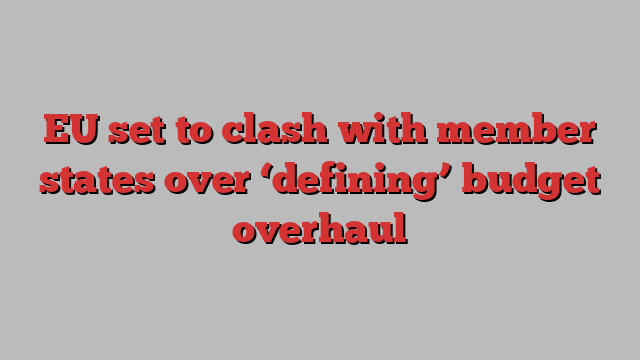
Unlock the Editor’s Digest for free
Roula Khalaf, Editor of the FT, selects her favourite stories in this weekly newsletter.
Brussels is set to push EU member states towards a radical overhaul of its €1.2tn common budget, tying payments to economic reforms instead of automatically compensating poorer countries.
Talks on the next long-term budget round will start in the autumn, kicking off one of the EU’s most complex and fraught policy negotiations.
One of the most contentious changes sought by the European Commission will be to revamp rules governing so-called cohesion funds, which distribute tens of billions of euros a year to close the economic gap between richer and poorer parts of the union.
Advocates of the changes argue attaching reforms — such as changes to pensions, tax or labour laws — to payouts will make spending more effective and impactful.
One EU official briefed on initial work for the 2028-34 budget said so-called net recipient countries — member states that receive more from the budget than they put into it — “need to understand that the world where they get an envelope of cohesion funding with no conditions . . . is gone”.
A second EU official acknowledged the shift would be “a pretty defining moment”.
But such a change is likely to provoke intense disagreement among the EU’s 27 member states, who must now spend years attempting to reach unanimous agreement on the size of the common budget and what it should be spent on.
Beset with challenges ranging from the war in Ukraine to retooling its economy to compete with China and the US, Brussels is already struggling to stretch its current budget, which runs until 2028.
Under the existing budget, about a third goes towards closing gaps between poorer and richer regions and another third is paid out in agricultural subsidies. The rest is divided between research funding, development aid and the cost of running the EU’s machinery.
The proposed conditionality clauses would mimic those attached to the EU’s pandemic-era €800bn fund, which disbursed money based on countries implementing pre-agreed reforms and investments. Those included a labour market reform in Spain, changes to Italy’s justice system and adapting Belgium’s pensions system.
But access to cohesion funds is seen as sacrosanct by many states in central and eastern Europe that joined the EU in the early 2000s with the promise of payouts in exchange for opening up their economies to western European investors.
Hungary, Slovakia and the Baltic states are the top five net recipients of cohesion funds as a percentage of national income, according to a study by the German Economic Institute.
Governments in these countries are likely to oppose any moves that they see as potentially limiting their payouts. Countries that pay in more to the EU budget than they get back are more supportive, however.
“Pretty much the only way you can convince net payers to contribute more is to put more strings attached on recipients,” said a senior EU diplomat.
Talks over the common budget begin in the autumn, with a formal proposal expected in 2025.
The European Commission could also impose big changes to the way funding streams are bundled, switching from a multitude of programs into a single country “plan”. It is considering other changes, including whether to shorten the duration of the common budget from seven years to five.
Proponents in the commission said the sweeping reforms would make the budget more efficient at meeting priorities such as climate change, boosting homegrown industry and reacting to unexpected crises.
“The way we agree on the EU budget has way too much inertia built in,” said a third EU official. “We need to be closer to reality,”
However, several special interest groups and regional authorities believe the changes constitute a mission creep by the commission.
“There are widespread concerns among many of the EU’s regions about what this kind of shift could mean for their critical funding,” said Ľubica Karvašová, vice-chair of the European parliament’s Committee on Regional Development, in response to plans for changes to funding streams.
“No local mayor wants their EU financial flows to rely completely on their central government enacting a reform plan, especially given how that leaves it open to domestic political leverage.”
At the moment, the EU budget is largely financed by countries according to their economic weight, split between net payers and net beneficiaries. Historically it is worth about 1 per cent of EU GDP.
Some EU officials argue the budget is not sufficient to deal with the bloc’s myriad challenges and requires more money from capitals.
“There is nothing, legally speaking, preventing the EU budget to be bigger than 1 per cent [of EU GDP],” commission executive vice-president Valdis Dombrovskis told the Financial Times.
Several countries have expressed interest in their commissioner heading the budget department of the commission.
Poland’s Prime Minister Donald Tusk this month nominated Piotr Serafin, now Warsaw’s ambassador to the EU, as the country’s candidate for commissioner. Tusk said it was “very likely” that he would end up with the budget portfolio.
However, richer countries are skittish about handing oversight over the EU’s purse to a net beneficiary such as Poland.
“To be frank, the big contributors would be far more comfortable with one of their own managing the overhaul,” said a second senior EU diplomat.
Additional reporting by Raphael Minder in Warsaw